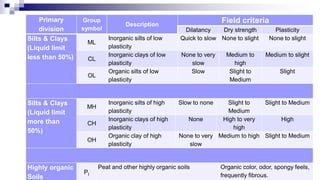1.identification classification of soil
- 1. WELCOME TO OUR PRESENTATION Submitted To Prof. Dr. Md. Abu Taiyab Dept. Of CE. Mr. Md . Ariful Islam Lecturer, Dept. of CE. Prepared By MD. Parvej ID: 131046 Syed Shahjalal ID: 131021 DEPARTMENT OF CIVIL ENGINEERING. DHAKA UNIVERSITY OF ENGINEERING & TECHNOLOGY ,GAZIPUR.
- 2. IDENTIFICATION AND CLASSIFICATION OF SOIL COURSE NO. CE -3302 GEOTECHNINICAL ENGINEERING -I SESSIONAL
- 3. Objectives ’ü« The test is Standardized in ASTM D 2487 as ŌĆ£ Unified Soil Classification SystemŌĆØ. Test Standard The classification of soils is based on a combination of visual observation and laboratory tests. This system needs to be comprehensive, while still being reasonable, systematic and concise.
- 4. STEP-1 (IDENTIFYING AS COARSE GRAINED SOIL OR FINE GRAINED SOIL) Soil Sample Fine grained soil Coarse grained soil ŌĆó Naked eye visibility>50% ŌĆó Size :-particle size within76mm to 0.075mm ŌĆó Naked eye visibility<50% ŌĆó Size :- particle size less than 0.075mm
- 5. Naming Convention Primary Letter Soil compone nt Size & Description G Gravel Coarse:75mm-19mm Fine:19mm-4.75mm S Sand Coarse:4.75mm-2.0mm, Medium: 2.0mm-425╬╝m, Fine: 425╬╝m -75╬╝m M Silt Particles smaller than 75╬╝m, identified by plasticity C Clay Particles smaller than 75╬╝m, identified by plasticity O Organic Metter Organic matter in various size & stages of decomposition Pt Peat Highly organic soils Secondary Letter Description W Well graded P Poorly graded M Non- plastic fines i.e. silt C Plastics fines i.e. clay L Low plasticity, WLL< 50% H High plasticity, WLL>50%
- 6. STEP-2 (CLASSIFYING COARSE GRAINED SOIL) Coarse Grained Soil Sandy soil Gravelly soil GPGW Dust Gravel Fines>12% Clean Gravel Fines<5% Dust sand Fines>12% Clean sand Fines<5% GM SPSW SCSM GC
- 7. STEP-3 (CLASSIFYING FINE GRAINED SOIL) Fine Grained Soil Organic Soil Inorganic soil ŌĆó Dispersion Test ŌĆó Shaking or Dilatency Test ŌĆó Plasticity Test ŌĆó Dry Strength Test ŌĆó Presence of organic matter ŌĆó Dark Gray to Black Color ŌĆó Oder of Decaying vegetation ŌĆó More compressible
- 8. Primary division Group symbol Description Field criteria Dilatancy Dry strength Plasticity Silts & Clays (Liquid limit less than 50%) ML Inorganic silts of low plasticity Quick to slow None to slight None to slight CL Inorganic clays of low plasticity None to very slow Medium to high Medium to slight OL Organic silts of low plasticity Slow Slight to Medium Slight Silts & Clays (Liquid limit more than 50%) MH Inorganic silts of high plasticity Slow to none Slight to Medium Slight to Medium CH Inorganic clays of high plasticity None High to very high High OH Organic clay of high plasticity None to very slow Medium to high Slight to Medium Highly organic Soils Pt Peat and other highly organic soils Organic color, odor, spongy feels, frequently fibrous.
- 9. Test of inorganic soil Test name Performance Observation comments ŌĆó Dispersion Test The soil was allowed to settled in water Most of soil grain was settled within 30sec Sandy Silt ŌĆó Shaking or Dilatency Test A moist soil mass was shaken on palm by tipping Slow Clayey soil ŌĆó Plasticity Test Manipulation of 3mm thread 3mm thread was formed Silty Clay ŌĆó Dry Strength Test A dry 3mm rolled fragment was enforced. A great effort was needed Clay soil
- 10. & DO YOU HAVE ANY QUESTION???? THANK YOU










